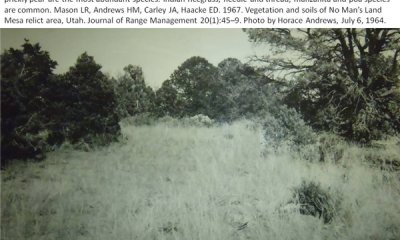
Upland Sand (Utah Juniper-Pinyon)
Scenario model
Current ecosystem state
Select a state
Management practices/drivers
Select a transition or restoration pathway
- Transition T1a More details
-
No transition or restoration pathway between the selected states has been described
Target ecosystem state
Select a state
Description
The reference state is characterized by a diverse mixture of grasses, forbs, shrubs and trees. Two-needle pinyon and Utah juniper dominate the tree canopy, with mountain big sagebrush, Gambel oak, manzanita, Mormon tea, prickly pear, and various other shrub species common. Sandhill muhly is the most common grass, especially in relatively sandy soils, with blue grama dominant in less sandy areas. Grasses are diverse and often include Indian ricegrass, needleandthread, mesa dropseed, bluegrass, muttongrass, sand dropseed, and squirreltail.
Submodel
Description
This state is functionally and structurally similar to state 1, however it allows for the presence of non-native species. As a result of the establishment of non-native species, the resillience of this state is less than the reference state.
Submodel
Mechanism
This transition occurs with the establishment of non-native invasive species, such as cheatgrass. Although disturbances such as roads, recreation, and grazing may facilitate the establishment of non-native species, they may establish on this site in the absence of major soil disturbances.
Model keys
Briefcase
Add ecological sites and Major Land Resource Areas to your briefcase by clicking on the briefcase (![]() ) icon wherever it occurs. Drag and drop items to reorder. Cookies are used to store briefcase items between browsing sessions. Because of this, the number of items that can be added to your briefcase is limited, and briefcase items added on one device and browser cannot be accessed from another device or browser. Users who do not wish to place cookies on their devices should not use the briefcase tool. Briefcase cookies serve no other purpose than described here and are deleted whenever browsing history is cleared.
) icon wherever it occurs. Drag and drop items to reorder. Cookies are used to store briefcase items between browsing sessions. Because of this, the number of items that can be added to your briefcase is limited, and briefcase items added on one device and browser cannot be accessed from another device or browser. Users who do not wish to place cookies on their devices should not use the briefcase tool. Briefcase cookies serve no other purpose than described here and are deleted whenever browsing history is cleared.
Ecological sites
Major Land Resource Areas
The Ecosystem Dynamics Interpretive Tool is an information system framework developed by the USDA-ARS Jornada Experimental Range, USDA Natural Resources Conservation Service, and New Mexico State University.
